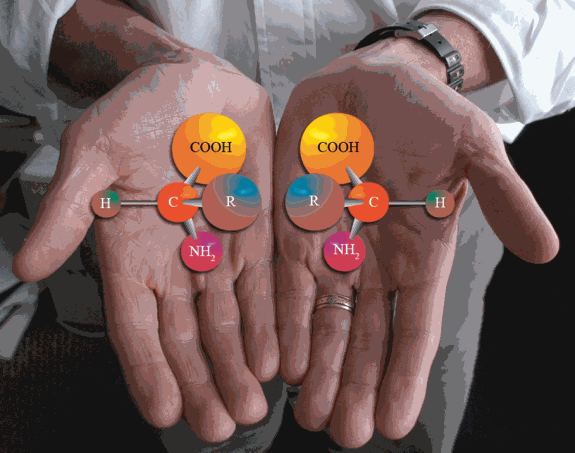Many of the basic molecules necessary for life on Earth possess a particular handedness (or chirality). Why one chirality in these molecules is preferred over the other, however, has been one of the long-standing questions in biochemistry. The researchers in this study show how a preferred chirality can be introduced into organic molecules by reactions induced by spin-polarized secondary electrons produced by irradiation of a magnetic substrate. Such a mechanism could help explain the chiral preference in pre-biological molecules on the early Earth.
Understanding how the molecules necessary for life originated is one of the most basic scientific problems in modern biochemistry. In 1953 Miller and Urey demonstrated that an electrical discharge in a mixture of common gases produced reactions that lead to the creation of important pre-biological molecules such as amino acids. In more recent years, the popular literature has showcased several other approaches which produce biological molecules, such as irradiation of ices found on interstellar dust grains. One of the great remaining unanswered questions, though, is how does biological handedness arise?
Due to the fundamental nature that chirality plays in biological processes, researchers have been striving for years to discover the possible mechanisms that could have led to this property. Possible external agents that are thought to induce chirality in organic molecules, such as circularly polarized ultraviolet photons and longitudinal spin-polarized electrons, have been extensively investigated with varying degrees of success.
The researchers, from Argonne National Laboratory and Ames Laboratory, used x-ray photoelectron spectroscopy at the X-ray Operations and Research 4-ID-C beamline at the APS to measure the secondary electron photolysis reaction rate of a model chiral compound, (R)- or (S)-2-butanol (CH3-CHOH-C2H5), adsorbed on a magnetized permalloy (Fe0.2Ni0.8) substrate. Changing the magnetization direction of the substrate with respect to the direction of the x-ray beam reverses the spin polarization of the secondary electrons. The experiment shows that there is an enhancement of ~10% in the rate of C-O bond cleavage depending on the molecule chirality and the spin polarization of the substrate secondary electrons. This enhancement is well above that seen in most previous studies based on other mechanisms. Furthermore, these prior experiments were predicated on mechanisms that were more limited in their scope. Studies using circularly polarized photons, for example, require ultraviolet light within a narrow spectral band while those based on spin-polarized electrons need radioactive sources that are not widespread.
The present mechanism, on the other hand, is more general in that it requires only a magnetic substrate and a source of ionizing radiation. Iron is one of the most common elements and is magnetic in many forms, and ionizing radiation and magnetic fields are ubiquitous throughout the universe. It is easy to imagine numerous scenarios where a magnetized iron substrate in an interstellar dust grain, a comet, a meteor, or on a primitive planet surface would have produced spin-polarized secondary electrons as the result of irradiation. Furthermore, low-energy, primary spin-polarized electrons can also be produced directly by the interaction of circularly polarized ultraviolet light with a nonmagnetic substrate. The results presented in this study demonstrate how low-energy, spin-polarized electrons interacting with adsorbed chiral molecules could produce a significant excess of a given chiraity in pre-biological molecules.
— Richard Rosenberg
Contact: Richard Rosenberg, rar@aps.anl.gov
See: R. A. Rosenberg, M. Abu Haija, and P. J. Ryan, “Chiral-Selective Chemistry Induced by Spin-Polarized Secondary Electrons from a Magnetic Substrate,” Phys. Rev. Lett. 101, 178301 (2008). DOI: 10.1103/PhysRevLett.101.178301
This work and the APS are supported by the U.S. Department of Energy, Office of Science, Office of Basic Energy Sciences under Contract No. DE-AC02-06CH11357.
The nation's first national laboratory, Argonne conducts leading-edge basic and applied scientific research in virtually every scientific discipline. Argonne researchers work closely with researchers from hundreds of companies, universities, and federal, state and municipal agencies to help them solve their specific problems, advance America 's scientific leadership and prepare the nation for a better future. With employees from more than 60 nations, Argonne is managed by UChicago Argonne, LLC for the U.S. Department of Energy's Office of Science.

